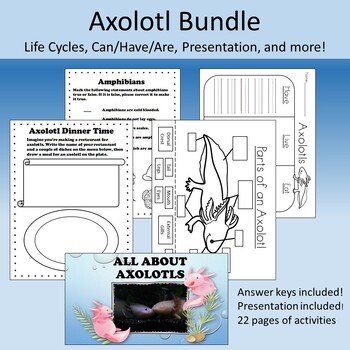All My Axolotl Resources- Anatomy, Presentation, Can/Have/Are, and more!
PinkFrogScience
6 Followers
Grade Levels
K - 5th
Subjects
Resource Type
Standards
CCSSCCRA.L.6
NGSS4-LS1-1
NGSSK-LS1-1
NGSS3-LS1-1
NGSS4-ESS3-1
Formats Included
- Zip
PinkFrogScience
6 Followers
Products in this Bundle (3)
Description
This includes 3 products: Labeling parts of an axolotl (4 versions: cut and paste, tracing words, write-in with word bank, write in without word bank), Axolotls Can, Have, Are/ Have, Eat, Live (3 versions of each graphic organizer, plus a craft activity and a writing frame), and my axolotl presentation and activities (life cycle, animal classification, research project, and more).
I would recommend using these for a unit, as they go well with various science standards.
Total Pages
Answer Key
Included
Teaching Duration
Other
Last updated 7 months ago
Report this resource to TPT
Reported resources will be reviewed by our team. Report this resource to let us know if this resource violates TPT’s content guidelines.
Standards
to see state-specific standards (only available in the US).
CCSSCCRA.L.6
Acquire and use accurately a range of general academic and domain-specific words and phrases sufficient for reading, writing, speaking, and listening at the college and career readiness level; demonstrate independence in gathering vocabulary knowledge when encountering an unknown term important to comprehension or expression.
NGSS4-LS1-1
Construct an argument that plants and animals have internal and external structures that function to support survival, growth, behavior, and reproduction. Examples of structures could include thorns, stems, roots, colored petals, heart, stomach, lung, brain, and skin. Assessment is limited to macroscopic structures within plant and animal systems.
NGSSK-LS1-1
Use observations to describe patterns of what plants and animals (including humans) need to survive. Examples of patterns could include that animals need to take in food but plants do not; the different kinds of food needed by different types of animals; the requirement of plants to have light; and, that all living things need water.
NGSS3-LS1-1
Develop models to describe that organisms have unique and diverse life cycles but all have in common birth, growth, reproduction, and death. Changes organisms go through during their life form a pattern. Assessment of plant life cycles is limited to those of flowering plants. Assessment does not include details of human reproduction.
NGSS4-ESS3-1
Obtain and combine information to describe that energy and fuels are derived from natural resources and that their uses affect the environment. Examples of renewable energy resources could include wind energy, water behind dams, and sunlight; non-renewable energy resources are fossil fuels and fissile materials. Examples of environmental effects could include loss of habitat due to dams, loss of habitat due to surface mining, and air pollution from burning of fossil fuels.





